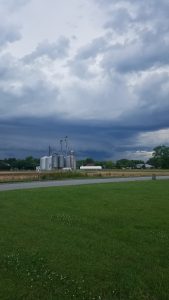Jarrod Miller, Extension Educator, Somerset County

A storm brought random hail to Maryland’s Lower Eastern Shore last week. Fields only a mile apart went undamaged, while other suffered shredding and defoliation. Many farmers may have questions about replanting, yield loss and pathogen damage.The University of Nebraska has also seen some recent damage due to hail and have summarized some great information about evaluation here: http://cropwatch.unl.edu/2017/evaluating-early-season-hail-damage-corn.


Some important points form Nebraska include being patient when evaluating loss. Producers should keep planting empty fields while watching hail damage recovery, re-evaluating in about 7-10 days. Consulting crop insurance agents will help determine whether losses require replanting. Research has observed that complete defoliation of V2-V5 corn has resulted in 8.7 to 23% losses, possibly due to reduced ear size from lower leaf area. Shredding of corn leaves from V2-V5 stage has resulted in a 4% yield loss. Due to variability in hybrids, soil types and weather during the season, yield loss will also vary. Hail defoliation at V8 in Ohio resulted in abnormal tassel growth, which they suggested may cause pollination issues and yield loss later on (Thomison et al, 2017).
Another important question is fungicide applications following wounding by hail damage, which is addressed here: http://cropwatch.unl.edu/fungicide-use-corn-after-hail-or-wind-damage. Dr. Nidhi Rawat (University of Maryland) notes that disease favored by wounding in corn are not controlled by fungicides, these include Goss’s wilt, common smut and stalk rot. Goss’s wilt can be common after hail storms due to rain splash off of last years corn residue. The foliar diseases managed by fungicides (e.g., gray leaf spot, northern corn leaf blight, eye spot, and common rust on corn, and brown spot and frog eye on soybeans) are caused by pathogens that do not require wounds for infection.

Most soybeans have probably just emerged this time of year. Much like corn, soybeans should be evaluated 7-10 days following a hail storm for a stand count (http://extensionpublications.unl.edu/assets/pdf/ec128.pdf). Leaf loss during vegetative stages sets back plant growth, but not necessarily yields. Unlike corn, soybeans have several growth points. As long as growing points remain above the cotyledons, soybeans can recover. The image at the top of this article shows some damage to cotyledons and unifoliate leaves, so those plants have plenty of time to recover. However, the image to the left shows loss of cotyledons and possibly the growing point. Evaluation after 7-10 days may reveal that these plants have been lost.
Pioneer has an article on determining damage to soybean stands here: https://www.pioneer.com/home/site/us/agronomy/library/soybean-hail-decision-guide. /
